An In-Depth Look at the Ambitious Sunset Strip Arts & Advertising Program
Ask anyone who lives or grew up in Los Angeles about the Sunset Strip, and they’ll eagerly share a favorite memory. Cruising down the street with a fresh new driver’s license and friends on board. Catching a show at the Roxy. Gazing at billboards advertising iconic artists like the Beatles, Cher and the Who.
Now the Strip is about to enter a new era.
The Sunset Arts & Advertising Program, approved last year by the City of West Hollywood, plans to evolve the 1.5-mile stretch along Sunset Boulevard into a space marrying advertising with innovative architectural design, imaginative public spaces, preserved historic buildings and artist showcases. It’s a fresh, refined and ambitious project aimed at “bringing the billboard into the 21st century,” according to a city marketing brochure.
[mapsvg id=”9623″]
The revitalized Sunset Strip will turn advertising into an experience, a la Times Square, while also doing a lot more. It incorporates old-time Hollywood glamour with new-wave Silicon Valley tech.
When you think about it, this distinctly West Coast way to approach the project may be the best way to guarantee success.
“The City of West Hollywood’s Sunset Arts & Advertising Program embraces the legacy of creative, large-format advertising that has been a part of the Sunset Strip since automobiles first rolled along the boulevard,” West Hollywood Mayor Lindsey P. Horvath tells DASH TWO. “The creative designs are intended to thoughtfully integrate signs, sites and architecture to meet the city’s desired aesthetic while ensuring that projects are integrated to context and serve as good neighbors.”
Earlier this month, the Sunset Arts & Advertising Program completed its application screening process, choosing 21 projects that will move forward from the proposal to the approval stage. Once the projects have been okayed, it will take a few years for construction. So while we’re still in the early stages, the Strip is on the cusp of a generational redefining.
Here’s the story of how it came about, what it will look like, and how the process will unfold.
The History of Billboards on the Sunset Strip
The legend of the Sunset Strip billboard dates back more than 100 years, to the silent film period. Then, notes Sunset Arts & Advertising Program Manager Bryan Eck, the Hollywood moguls who lived in Beverly Hills wanted to develop a connection between their studios in East Hollywood and their homes in the West.
The Strip entered another boom period in the 1960s. From the moment Elektra Records put up its first board advertising The Doors (for the then-princely sum of $1,200 per month), the Strip became a cultural touchpoint. Having a board on the Strip became a status symbol. Artists knew they’d made it when their record label shelled out thousands to advertise their latest album. They’d have their pictures taken next to the boards. Bruce Springsteen famously defaced a board with his image late one night, calling it the “ugliest thing” he’d ever seen.
DJs cruising the Strip even decided what to play their listeners based on the billboards they saw. Perception (this band is big enough to advertise on the Strip!) quickly became reality (this band’s song is being played all the time!).
Until 1984, the Strip belonged to Los Angeles County, and the land was fairly unregulated, leading to a proliferation of larger outdoor advertising that wasn’t allowed in Beverly Hills or elsewhere in Los Angeles. The nostalgia of the boards combined with the rich music history of venues on the Strip — from Whisky a Go Go to the Rainbow Room to, more recently, Sky Bar — established the area as a must-see for visitors.
More recently, Netflix’s 2018 acquisition of more than a dozen billboards near Chateau Marmont and Sunset Plaza ruffled some feathers among the old guard bothered by the upstart’s push into yet another sacred space. But the streamer’s acquisitions merely underscored the continued value and prestige of the boards in the LA advertising landscape.
Eck says that today, signage along the Strip has become something Angelinos accept and even expect. He notes that the increased push for digital signage by advertisers made the city reconsider how to make signage a win-win — something that benefits advertisers as well as residents and businesses. “There was pressure to have more digital signage, so we said fine, but we’ll do it in a way that’s thoughtful and do it in a West Hollywood way,” he says. The strict demands of the program ensure the creative will be aesthetically pleasing and responsible while avoiding negative land usage issues.
Genesis of the Arts & Advertising Program
The program proposed by the City of West Hollywood last year was a work of self-improvement, really. With lots of interested parties to please, WeHo made public interest one of the central tenets of a new off-site signage policy introduced in March 2019. Those ideas form the backbone of the formalized Sunset Strip Arts & Advertising Program.
Noting that the Strip has the “densest concentration of off-site signage (billboards and tall wall signs) on the West Coast,” the policy outlines ideas for reshaping the architecture and the legacy of the area by integrating “off-site signs, entertainment, and public art into the existing iconic and historic setting.” The policy’s goal was “to ensure new high-quality signage projects that are creative, contextual for Sunset Boulevard, and sensitive to adjacent land uses.”
David Ehrlich, founder of sports, entertainment and outdoor media consulting firm FinWater Advisors, LLC, has assisted cities such as Denver and Atlanta with seeking new ways to present digital signage. A member of the Design Excellence Committee that evaluated the Sunset Strip proposals, Ehrlich says projects like these address multiple concerns for a city.
“West Hollywood gave it a really community component. Not only did they take the time to find great art, but you’ll also see outdoor seating areas, mini theaters. The city took things we’ve been learning for the last 10 years about these projects and took it to the maximum,” he says.
A New Vision for the Sunset Strip
Cities throughout Southern California have banned digital billboards, for all the usual reasons. They’re too distracting, they’re unsafe, they’re not pretty. Most of these claims have been disproven, but still the perceptions persist.
West Hollywood took pains to make its vision just as appealing to vendors and advertisers as it is to pedestrians and Sunset Strip residents. Ehrlich says finding that sweet spot is critical to gaining the support of all sides. “They can be such a fantastic tool to build support throughout the community,” he says. “To demand that those buying signage in the community also make contributions beyond signage to the arts and other things is a really positive transition welcomed by those who live in the cities. It’s a way to invest into the arts and change the entire dynamic of how people see a place.”
“The addition of new digital technology and dynamic art and advertising content will capture the spirit of the legendary rock ‘n’ roll billboards of yesteryear while embracing a 21st century approach to the ever-evolving Sunset Strip,” Mayor Horvath says.
The “advertising as art” vision incorporates six factors:
- Preserves the past
- Celebrates the culture of the Strip
- Supports artistic expression
- Rehabilitates existing buildings
- Generates new pedestrian-oriented development
- Creates signage that is creative and integrated into architecture
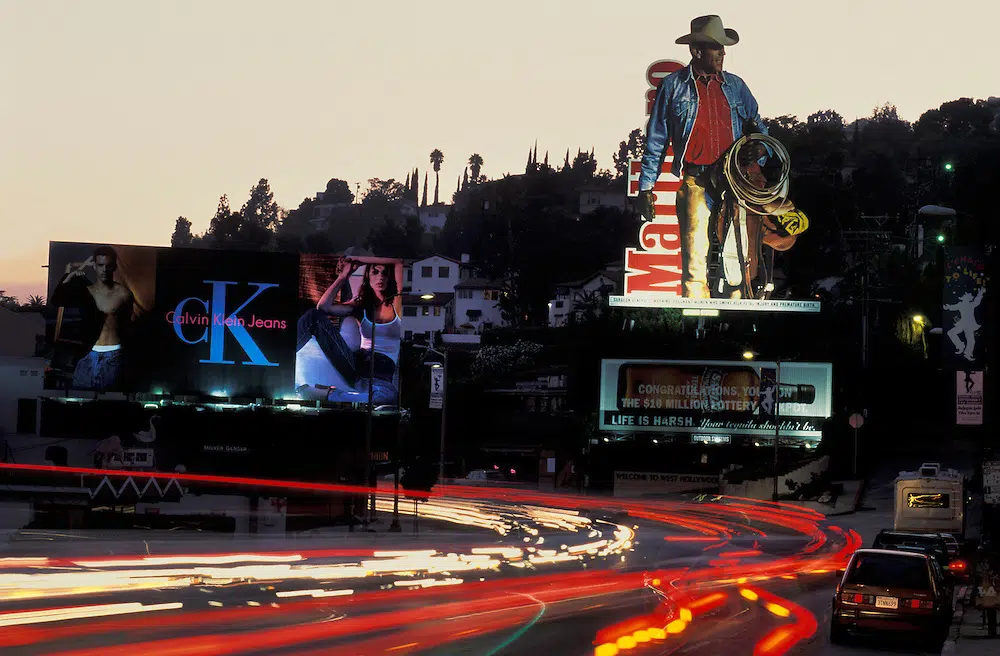
Journalist Frances Anderton hosts a show about Los Angeles design and architecture on KCRW. She also served on the Design Excellence Committee.

“Just as those rock ‘n roll billboards reflected their time and the Marlboro Man reflected his, West Hollywood wants to invigorate the billboard energy on the Strip and make it relevant to now,” says Anderton. “They definitely want show-stopping, but they don’t want it to be uniformly show-stopping. They want a range. It should be a billboard zoo, where you can go and see the different species of billboards.”
Choosing the Winning Submissions
The city knew if it opened the proposal process to anyone, everyone would apply. The applicants were limited, and 43 projects were submitted for the screening process. Custom shapes and high-quality materials were musts.
The proposals included photo simulations of the proposed outcomes of the projects. “The city quite clearly felt a billboard doesn’t have to be a rectangular screen that sits atop a building. All the proposals were about breaking down the format,” Anderton said.
The seven-member Design Excellence Committee (composed of experts in architecture, urban design, advertising, digital sign technology, arts, media and historic preservation) reviewed each proposal and scored it on 33 criteria related to:
- Economic development
- Sustainability
- Adaptable design
- Design quality
- Public benefit
The committee averaged the scores for each project, then ranked them from highest to lowest. The top 21 were offered inaugural spots in the program. Next, all those designs must go through the city’s formal approval process, with proposals heading to the planning commission and city council.
The city envisions the first new boards rolling out by early 2021, though some will take much longer to create. Construction on this first phase of the plan will happen for the next several years.
Ehrlich says he was pleased to even see one of the Big Three billboard vendors (Outfront Media) submit a project application, which was approved.
“Outfront’s sign looks like these round eyeglasses that interact with you — I’d definitely never seen that before,” he says. “Outfront is a gigantic company. They normally deal with installations in the thousands. To get them to focus artistically on one sign, to me, is a huge change in the industry, and I say that respectfully. They came up with something really cool.”
By the Numbers: A Revenue-Sharing Program
Vendors already have a lot invested in their projects, from the time and expense of coming up with the project application to the services of artists and architects in refining that vision. Eventually, they should make a tidy profit.
The projects all include revenue sharing with the City of West Hollywood. The city declined to project firm earnings numbers but noted that a digital sign can generate six times the revenue of a “typical static sign” on Sunset Boulevard.
Vendors we spoke to on background told us they expect to charge four to six times what a digital board would bring in on the Strip for a sign with multiple advertisers filling slots. Some vendors said they would prefer to make deals with a single company to “own” the sign, with a long-term contract potentially worth millions.
“Because the city will get a share of that revenue, it’s mutually beneficial if the signs command a high value,” Eck says. “We learned from the industry that the more well-designed and recognizable the spaces become, the higher the prices the vendors can charge, the more revenue that can be shared with the city to provide public benefits and support city services.”
A Focus on the Architecture
Elizabeth Timme, an architect and co-executive director of the nonprofit LA-Más, served on the Design Excellence Committee. “The key was to drive and support other public amenities and resources in tandem with the signage to provide a public benefit,” she says. “They had to display income potential. Size, scale and placement all mattered. And we also looked at how the assemblage and addition of multiple signage pieces reinforces the very Sunset Strip identity.”
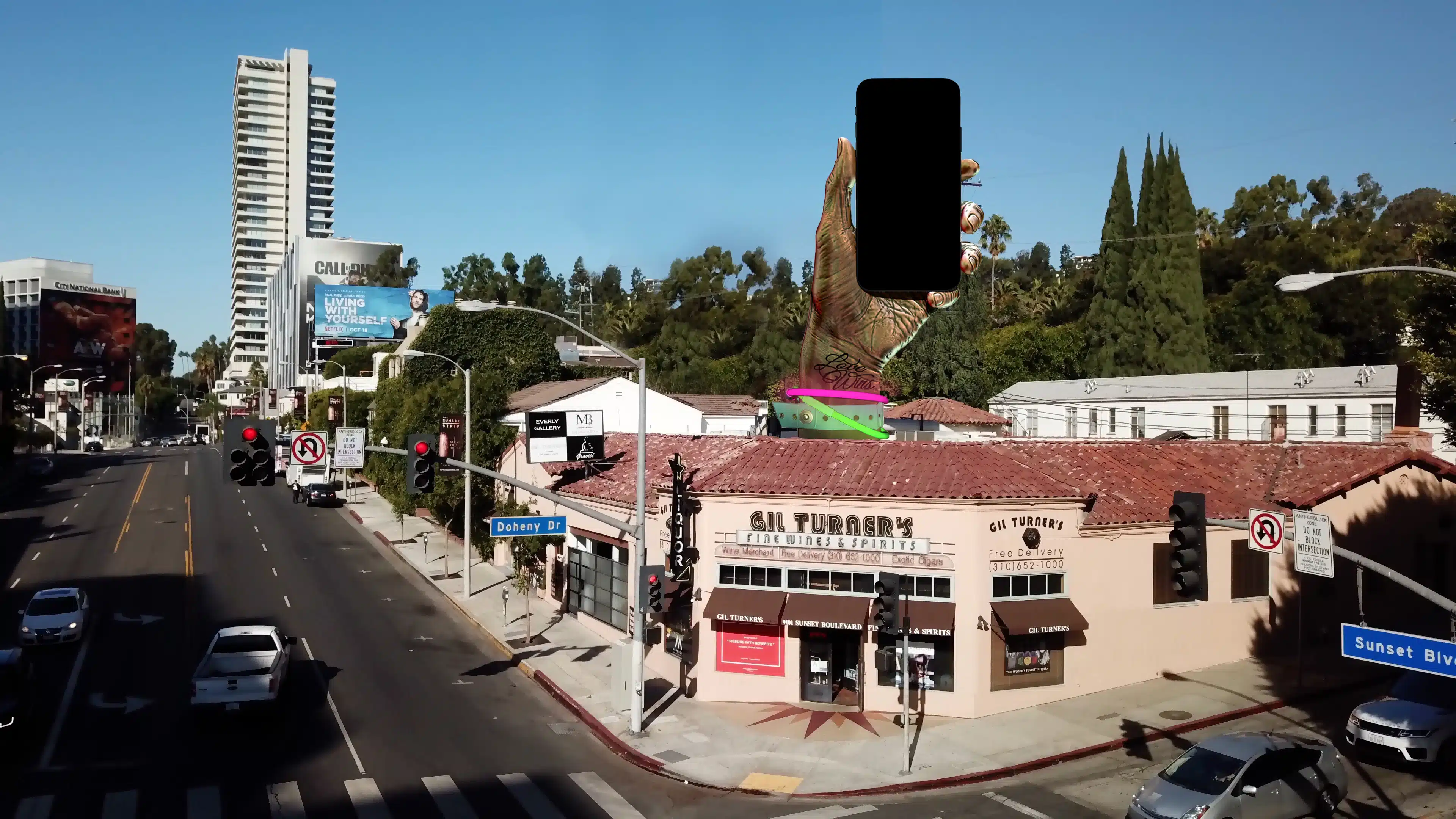
She saw many architectural details in the project applications that she had never seen before. She points to iKahan Media’s “Hand & Phone (Love Wins)” as a potential standout. The concept for the signage, by artist Alex Israel, shows a hand holding a smartphone. In a nod to the Strip’s musical history, the wrist wears what appears to be a band you’d get at a concert, along with several bracelets that glow in the dark.
“You just know it’s going to be one of the future landmark pieces, iconic, like something you’d see in Las Vegas,” Timme says. “There’s a showiness that’s so unique. The collaboration with the artist is so thoughtful, it was a pleasure to see.”
The vendor behind the concept, iKahan Media, believes the rendering speaks to bigger themes. “Alex Israel’s concept was thinking about the time and place in history that signifies what we’re doing right now. If Rodan’s famous sculpture had been made in 2020, he might have had a phone in his hand,” says Alex Kahan, CEO of iKahan Media. “There could be technology advances so that 20 years in the future, they’ll look back and say what the heck is that, like we’d say with a rotary phone today.”
As the best public-private partnerships, this opens doors for sponsorships all around. Kahan says the company is exploring branding the phone, which displays the digital billboard screen, as part of a partnership with a smartphone manufacturer.
Architecture considerations included buildings as well as new billboard designs. Timme notes the historic preservation projects presented interesting architectural challenges. Some buildings were decades old, introverted and in danger of being demolished. “A few projects had to navigate the line of wanting to be an homage but not a Disneyland, not a theme park. They managed to do it very well, and that was cool,” she says.
Being a Good Neighbor: Reconciling Digital Boards With Nearby Residents
Anderton, the public radio journalist, was particularly impressed with the proposals’ “good neighbor” policies. “Unlike in Santa Monica, where they said no to digital, West Hollywood said yes,” Anderton says. “But the city didn’t want to create something unpleasant for pedestrians or nearby residents or dangerous to a driver. It should be something that catches your eye but doesn’t cause you to crash into the car in front of you.”
The policy points boil down to: Billboards can’t be a nuisance.
“We took about eight years of study to get it right,” Eck says. “We used economists and people who know the sign industry to help determine the best size and recommended distribution of where to allow the projects to go. We worked with lighting and illumination experts and traffic safety experts to have really strict operational and lighting controls that limit the intensity of the light off the sign and how bright it can shine into the nearest residential parcels.” The city set different illumination standards for daytime and nighttime. The rules include nothing strobing, flashing or distracting. Other no-nos:
- Screens turning quickly from black to white
- Scrolling text
- Anything that looks like a stop sign or traffic light
Once construction begins, all signage will be subject to rigorous testing by the city. Each agreement also requires sign operators to make regular technology upgrades. “The city will publish a new set of standards every five years, so we’re not stuck with 2020 technology when new signs go up in 2048,” Eck says. “We want continually to have the best technology they can be, which will mitigate potential concerns that the adjoining residential neighborhoods could have.”
Design teams were also asked to prove they could limit energy use and demonstrate conservation efforts.
Across the Country, Billboard Districts Are Evolving
West Hollywood wants signage to look cool. It wants new ideas and fresh perspectives. And it wants to engage. The city required all proposals to provide community benefit with some combination of programming space for announcements and funding for public art and other initiatives.
The West Hollywood project may be just the beginning. The greater sophistication of billboards, coupled with a sharper focus on responsible architecture and community value, has made many cities eager to transform long-held ideas about advertising.
The new sensitivity demands that transformational ideas be inclusive and diverse — not just in terms of who’s determining what goes in the space but also in terms of presentation. Ehrlich says new signage and support needs to be purposeful.
He points to his project in Atlanta, which wanted to host the Super Bowl. Signage was designed to convince the NFL to award the game to the city, with digital signs tied together to prohibit outdoor competition. This comprehensive overhaul worked — the 2019 Super Bowl took place in Atlanta.
The Future of the Sunset Strip
The full vision of the new Strip won’t come to fruition for years. The designs still have to clear approval hurdles, and implementing them as envisioned will result in unforeseeable challenges. The second round of proposals will begin in 2021, using the same committee.
That said, everyone is excited about the potential transformation. “It’s an incredible opportunity to enhance an existing asset into something different, something iconic,” says Kahan. “Being involved in this was a no-brainer, from both a business and a professional standpoint. As a business, it increases the value of the billboard tremendously, and from a personal perspective, it will be a source of pride to know we built something that is more than a billboard. It’s a piece of art.”
“These projects will help preserve our history and culture,” says Eck. “They’re a benefit to the city and improvement to the public realm.”
Everything You Need to Know About the Sunset Strip Arts & Advertising Program
The projects that have been approved include:
- 9157 Sunset – Streamlined Arbor
- 9101 Sunset – Hand & Phone (Love Wins)
- 9015 Sunset – The Rainbow
- 8901 Sunset – The Whisky
- 8830 Sunset – Sunset Urban Theater
- 8760 Sunset – Mutato Muzika
- 8743 Sunset – Invisible Frame
- 8730 Sunset – The Sunset Worl
- 8501 Sunset – Suncienega Revival
- 8497 Sunset – The Now
- 8433 Sunset – The Comedy Store
- 8301 Sunset – The Source
- 8240 Sunset – The Harper
- 9200 Sunset – 9200 Sunset
- 9169 Sunset – The House on Sunset
- 9009 Sunset – The Roxy
Architects
Notable architects include:
- Eric Owen Moss (The Source, 8301 Sunset Blvd.)
- Lorcan O’Herlihy Architects [LOHA] (Hand & Phone (Love Wins, 9101 Sunset Blvd.)
- RCH Studios (The Comedy Store, 8433 Sunset Blvd.)
- Office Untitled (Invisible Frame, 8743 Sunset)
- Mithun|Hodgetts + Fung (The Now, 8497 Sunset)
Artists
Artists include:
- Alex Isreal (Hand & Phone (Love Wins), 9101 Sunset Blvd)
- Mark Mothersbaugh (Mutato Muzika, 8760 Sunset Blvd.)
- Refik Anadol (The Now, 8497 Sunset Blvd.)
Historic & Cultural Preservation
Five buildings have been selected to become city cultural resources as part of the program. Another five will use advertising revenue for ongoing maintenance and upgrades to historic and culturally significant buildings. These include:
- The Whiskey, Roxy, Rainbow and Comedy Store
- Gil Turner’s (9101 Sunset)
- The Beauty Pavilion (8760 Sunset)
- Constance Bennett Building (8743 Sunset)
- Burman Furs Building (9069 Sunset)
- 9157 Sunset
- Piazza del Sol (8439 Sunset)
Building Improvements
In order to qualify, projects needed to propose significant building renovations, make substantial façade upgrades, and/or undergo required seismic building upgrades.
Fourteen will include varying degrees of building upgrades that will enhance the Sunset Strip and breathe new life into these buildings.
Three ground-up new development projects are proposed with the program and mark a major investment for Sunset Boulevard:
- The Harper, 8240 Sunset
- The Source; 8301 Sunset
- The Now, 8497 Sunset
Public Space Improvements
These projects include new and improved enhancements to the public realm, including a new outdoor public gathering space as part of the Sunset Urban Theater, landscaping improvements at the Comedy Store, new parklets and new outdoor seating. These will provide beautification, places to gather, and views to the public art and advertising projects.
Arts Programming and Civic Announcements
Each project will contribute to a new digital arts program and can be utilized for civic announcements. The digital signs will dedicate 17.5% of operational time (91,980 minutes per year) to art and/or civic announcements.
Each project will include a monetary contribution that will include funding for City’s arts programming, such as curator and artist fees. Many of the projects incorporate artwork as well.




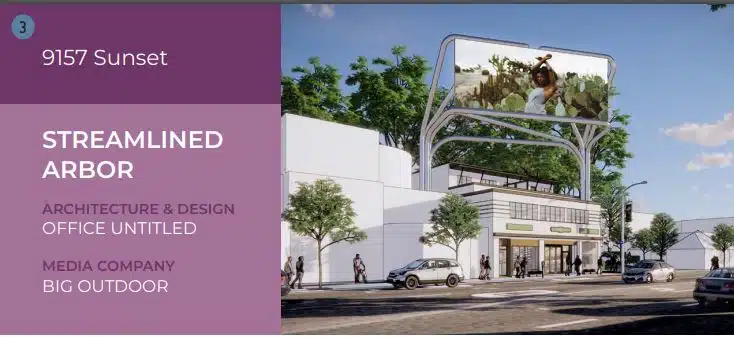

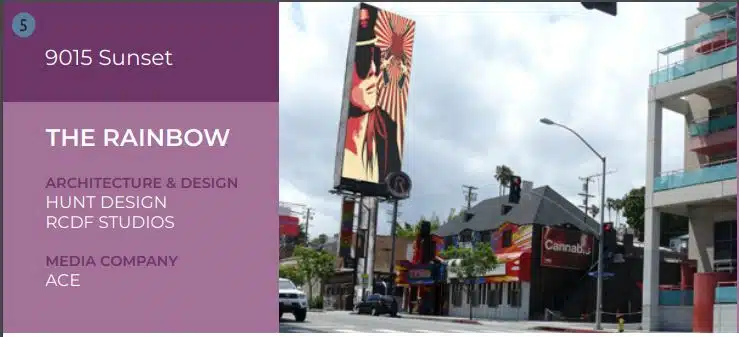
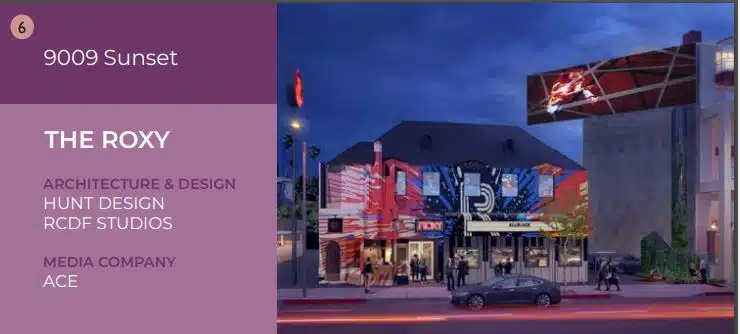
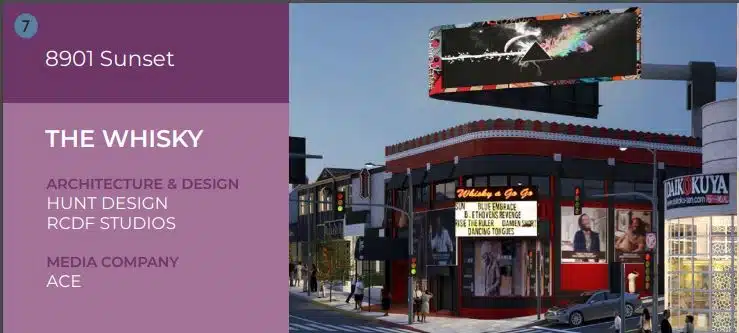
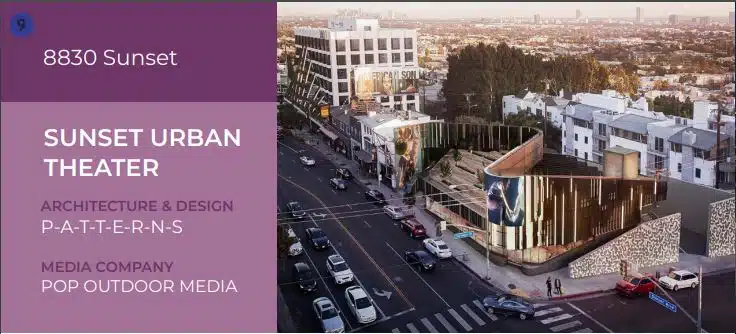

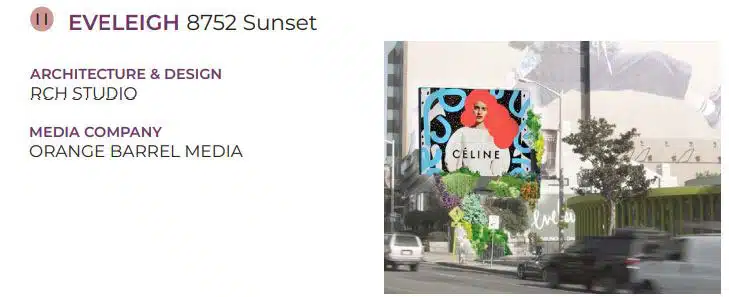
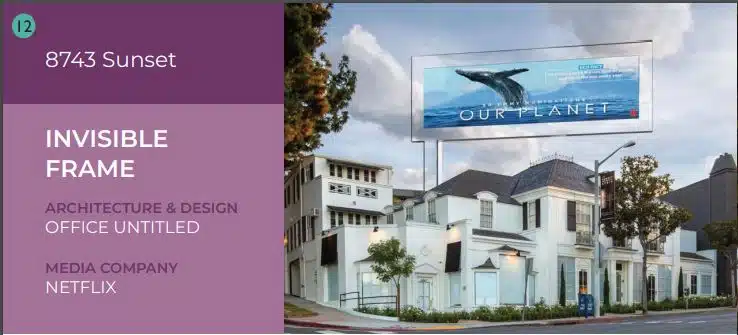
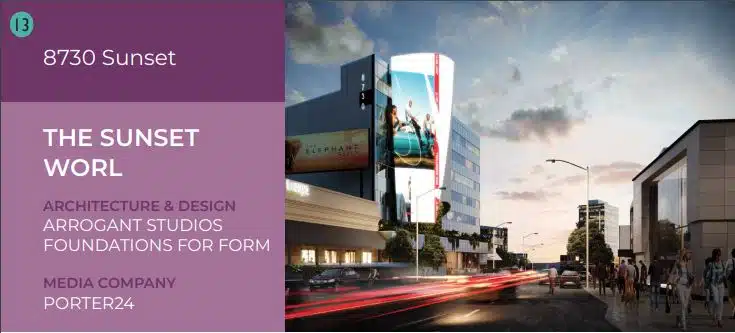
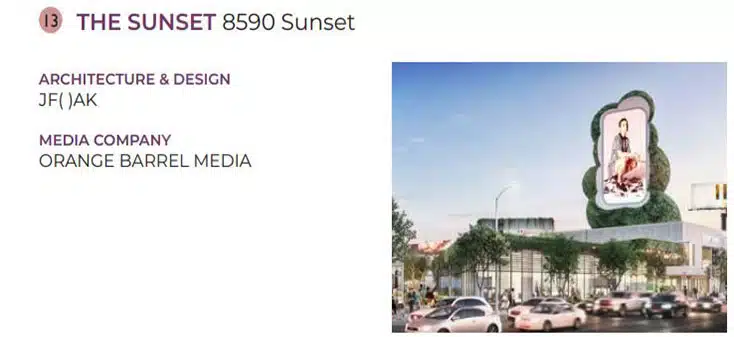

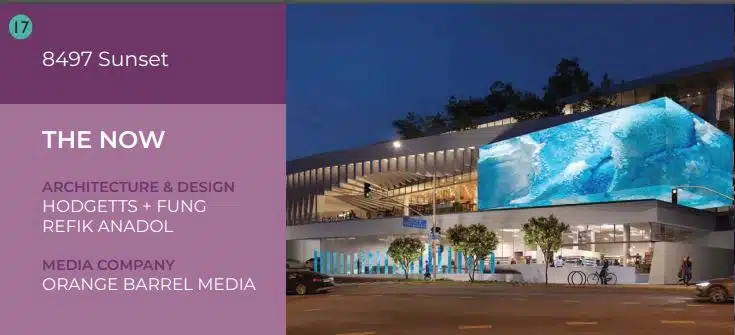
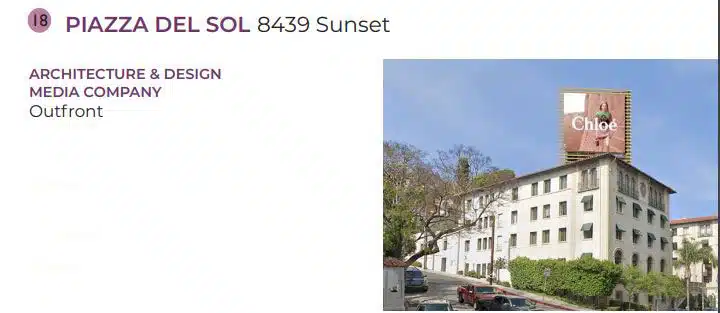
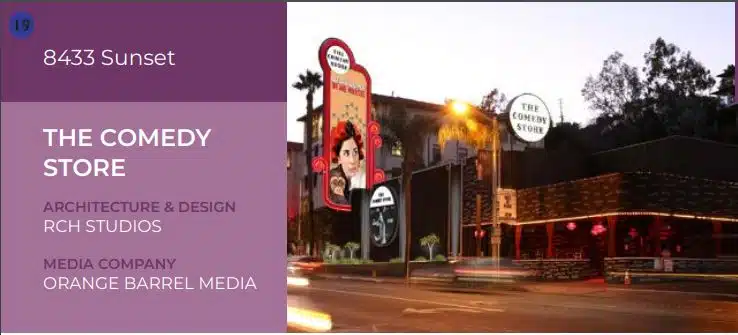
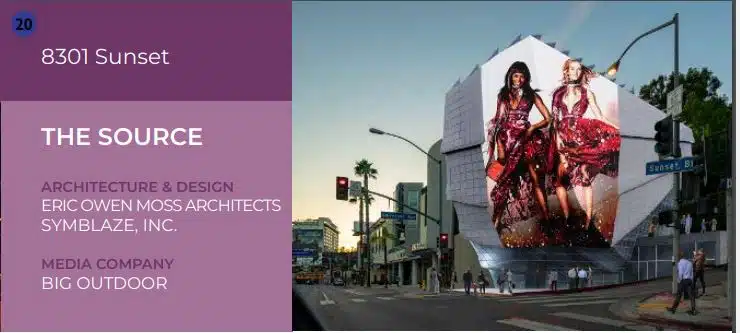
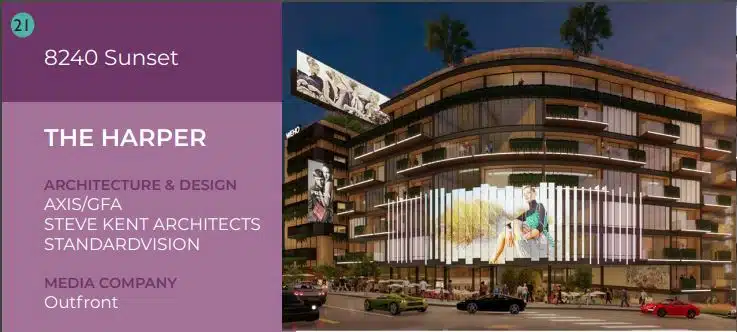
I really enjoyed reading this blog. Thank you Rodolfo for sharing details about this exciting community initiative in such a detailed manner. I now have a serious case of Out-of-Home envy. Our Municipal Planners (of Boston) should definitely read this too.
Excellent post! We are linking to this particularly great post on our site. Keep up the great writing. Beatriz Averell Bozovich